Thanks to Guest Author Peter Williams, who writes about his experiences with his XuShaoFa table tennis robot.
This robot has been very impressive: even though I have not yet graduated beyond the most basic of cards! The machine is very sturdy, and the control box although not very aesthetically pleasing is very strong. I have been using it for 3 to 4 months, with no problems at all…
The items below have been kept in the same format as the Amicus 3000 report, to make for easy comparison…. (and of course not because I am a lazy %*&# who can’t think of my own ideas….)
Price
This was really impressive – for the price of approximately $1500 Australian (half the Amicus 3000, and similar to the most basic of Newgys) – it appears to do almost everything the 3000 can do. Without analyzing each and every sequence, I can’t say what each can do that the others cannot – suffice to say that it is more than adequate for my needs.
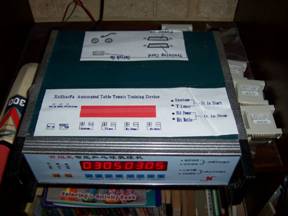 |
| As I said, not very pretty! |
A benefit over the more advanced others is that there is no complicated programming – you simply select the card you want, and the only adjustable items are the sequence number, duration, speed, and frequency – all operated via push buttons. In the example left, it is showing sequence 3, duration 5 (minutes), speed 3 (out of 10), and frequency 5.
Setup
Very simply – the machine clips onto the end of the table, so it is merely a matter of putting the ball tray on each side, the arms to carry the net, and the clips under the main body which fit under the table. Less than 10 minutes to assemble initially, and the setting up and taking down time now is literally seconds.
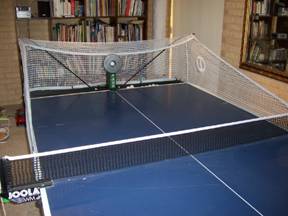 |
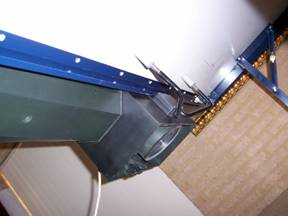 |
| Ready for action….. | The view from down under…. |
Manual
The manual is OK – the robot is very easy to assemble merely from looking at the pictures. Programming is a matter of looking at a brochure (in English) to see which sequence you wish to follow.
Here is a copy of the manual in PDF form for anyone interested in making a purchase – if anyone from the XuShaoFa company has a problem with me putting it up, just let me know and I’ll be happy to take it down.
Ease of Use
Main Controller
Main Controller
See picture above for front of controller – push buttons below the digital display allow you to cycle up and down to the correct number.
There are a total of 10 “cards” delivered with the machine – each of which has approximately 25 sequences (depending on the complexity)
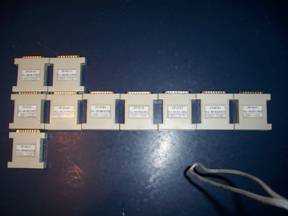 |
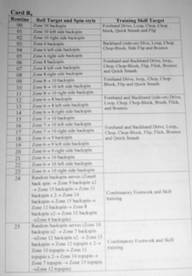 |
The card fits in at the back of the controller, above the power cord.
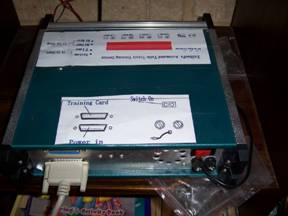
The receiving area is divided into 15 zones – 5 across, 3 deep – the zone the ball lands in is dictated by the card and sequence. There are also 9 different types of services (topspin, backspin, left topspin, no spin, etc) into the different zones.There is also the main on/off switch at the back.
With close to 300 different training procedures, serves etc, it will be a while before I get through them all – particularly if they are similar to the ones below!….
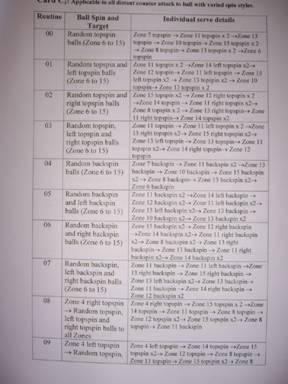
Remote Control
There is no remote….
Ball return and Ball Capacity
 |
 |
The tray clips onto the edge of the table, and the complete unit including the net comes on and off as one – which means there is no reassembly each time it is to be used. Balls are returned from the tray into the head, which has (apparently) 4 motors to allow for no-spin balls. Included with the robot were approximately 80 balls of approximately 2 star quality – more than good enough, and yet another saving….
In the case of a jam (very infrequent), the motor shuts down, and the sequence continues from where it left off once the blockage is cleared.
Mobility
Installing the robot is a matter of taking it from its storage place (!) – it is always connected electrically – and clipping it on the table.
 |
 |
The net ends are then slid over the stands, which stay permanently attached to the table (they are out of the way in normal play), and all is ready…
Maintenance
No problems as yet….. as stated previously, seems to be a very sturdy unit – the controller looks like surplus army issue!
Noise
Relatively quiet – there is a fairly low-pitched whine, which is barely noticeable (well, not if you are married, anyway)…
Heads/Motors
Supposedly it has 4 motors (not sure where I read this) – all I can say, is that it produces a no spin ball that is very difficult to handle…..
Feeder Height and Placement
This is where the Amicus 3000 probably has the edge – as the XuShaoFa clips on the table, and is not freestanding, you cannot have it in any other position other than that shown in the photographs (unless it was propped up on a small table, in which case the net and ball return wouldn’t work).
The robot height is also fixed.
Sidespin
The sidespin is set automatically by the routine chosen. The head is not adjusted for sidespin (which Butterfly is). At very high speed settings, the amount of sidespin can vary slightly – but I guess this is to be expected. I don’t believe that we have many loopers locally who can loop at 50m/sec (the maximum speed setting), and vary the amount of sidespin…
Conclusion
 The price is the cherry on the top…I’m very impressed – although I felt a bit nervous about ordering it over the internet, all arrived fine in a few weeks from order, and it has certainly helped certain aspects of my game – particularly those where I am experimenting with new shots due to new rubbers, and I need high repetitions of exactly the same speed and spin.
The price is the cherry on the top…I’m very impressed – although I felt a bit nervous about ordering it over the internet, all arrived fine in a few weeks from order, and it has certainly helped certain aspects of my game – particularly those where I am experimenting with new shots due to new rubbers, and I need high repetitions of exactly the same speed and spin.
Peter Williams January 2006
(with acknowledgement to Greg Letts)
Copyright 2006 Peter Williams
| Interested in Purchasing a Table Tennis Robot? | Buy Online |

